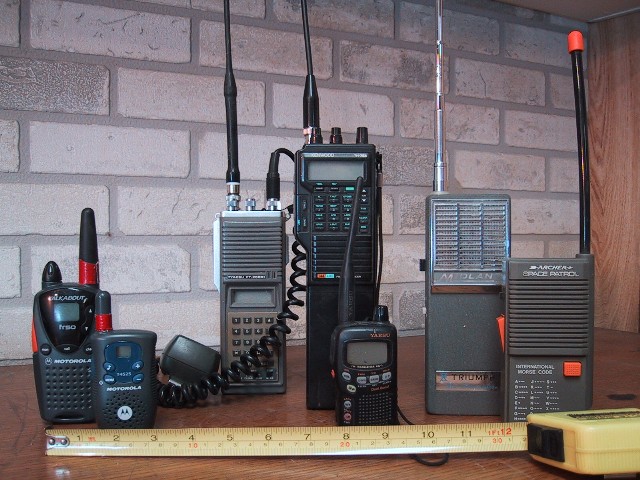Image: Recreational Walkie Talkies
Description: A collection of walkie-talkies, handheld portable two-way radios for recreational use. From left: Motorola FRS radio, purchased in 2002, which operates on the Family Radio Service band. Motorola dual band walkie-talkie, purchased in 2004, which can operate on either the FRS or the General Mobile Radio Service (GMRS) channels. On both these radios, the antenna is permanently attached, as required by FCC regulations for FRS gear. Early 1980s amateur radio transceiver for the 2 meter (144 MHz) band, complete with external speaker-mike, and DTMF keypad for remote repeater control and phone patch operation. Smaller amateur transciever for the 2 meter (144 MHz) and 70 cm (428 MHz) bands. Although similar in size to the smaller FRS units, it is much more versatile, has a higher transmit power, and can transmit on any of several hundred frequencies in two Amateur radio bands. A 1960s vintage toy walkie-talkie operating in the 27 MHz Citizens' Band; its 900 mm (36 inch)whip antenna is partly extended. This unit has a superheterodyne receiver, and 10 transistors. A mid-1980's toy walkie-talkie operating at very low power in the 49 MHz band, with a Morse code key and the Morse code printed on the case. This unit has only 4 transistors and no volume control or squelch. In addition, rather than the telescoping whip antenna common on earlier models, this unit has a rubber duck antenna, which is thought to be more robust and less dangerous to the user if broken, and has replaced telescoping antennas in virtually all children's two-way radio units. Commercial and emergency services walkie-talkies may be similar in size to the amateur units shown here, but generally have much better battery life, more rugged construction, and simpler controls, often restricting operation to only one or a few pre-programmed channels. In addition, many have ruggedizing features such as waterproofing (especially for outdoors and marine use) and intrinsically safe design for use in fire-prone industrial environments. The two older walkie-talkies on the right use only discrete transistors; all the more recent ones shown here use microprocessors and integrated circuits for most of their functions.
Title: Recreational Walkie Talkies
Credit: Transferred from en.wikipedia to Commons by Premeditated Chaos using CommonsHelper.
Author: Wtshymanski at English Wikipedia
Usage Terms: Public domain
License: Public domain
Attribution Required?: No
Image usage
The following page links to this image:


